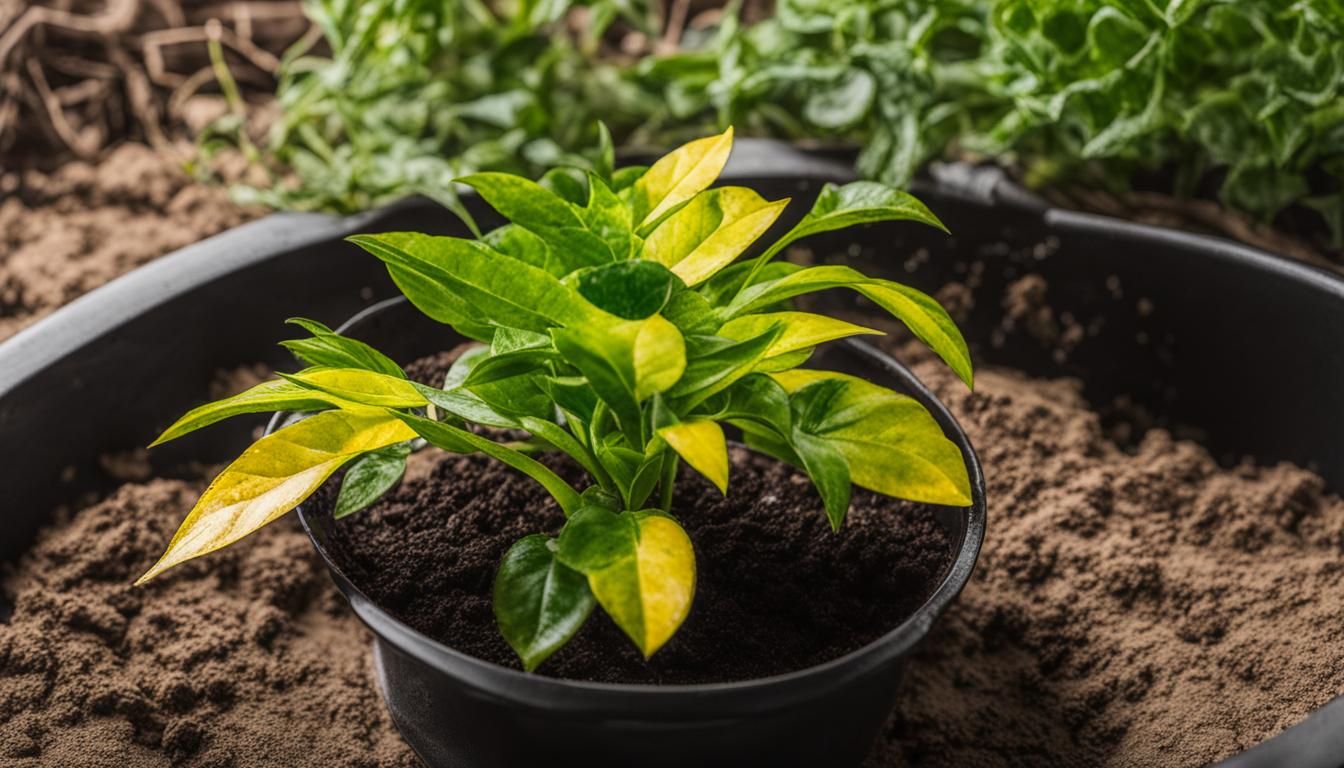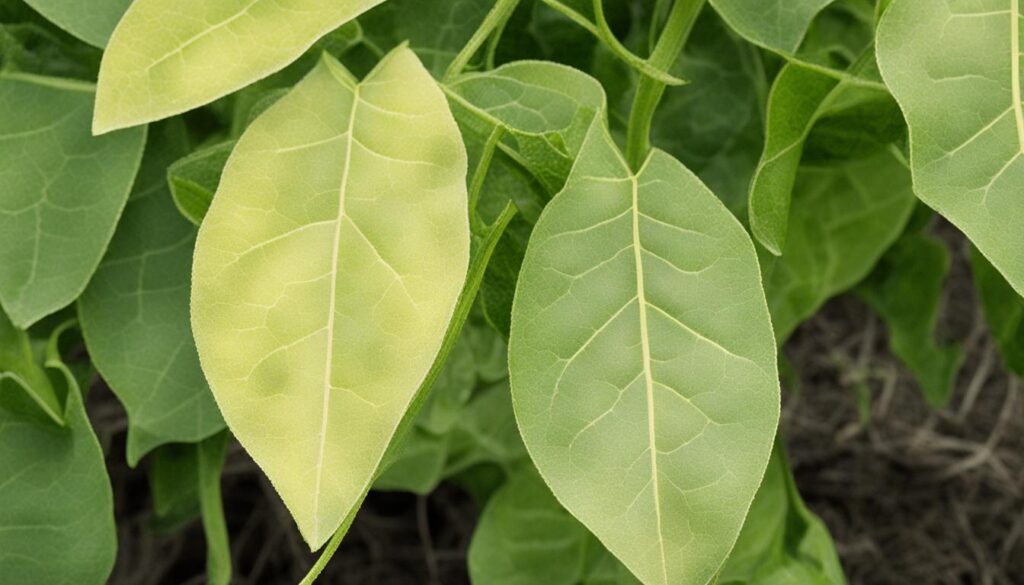
As a plant enthusiast, I know the importance of maintaining optimal plant nutrition for vibrant and healthy growth. One common challenge that many plant owners face is managing manganese deficiency.
This nutrient deficiency can lead to various symptoms and hinder the overall health of your plants. But fear not, for I’m here to share some valuable tips on how to effectively manage manganese deficiency in your plants!
Key Takeaways:
- Accurately identify the symptoms of manganese deficiency in your plants.
- Understand the causes of manganese deficiency, such as high soil pH and low organic matter levels.
- Consider treatment options like foliar application of manganese sulfate or band application of chelated manganese fertilizers.
- Prevent manganese deficiency by maintaining optimal soil pH levels and practicing balanced nutrient management.
- For specific crops like soybeans, cannabis, or tobacco, follow tailored tips for managing manganese deficiency in those plants.
Identifying Symptoms of Manganese Deficiency in Plants
Manganese deficiency in plants can have detrimental effects on their overall health and growth. It is essential to be able to identify the symptoms of this deficiency in order to take appropriate measures for plant care. While the specific symptoms may vary depending on the plant species, there are some common signs to look out for.
One characteristic symptom of manganese deficiency is the yellowing of leaves between the veins, known as interveinal chlorosis. This yellowing is often more pronounced in younger leaves.
Plants suffering from manganese deficiency may exhibit mottled brown spots on their leaves. These spots can gradually expand and lead to shredding of the leaves.
Another noticeable sign of manganese deficiency is stunted growth. Plants lacking sufficient manganese may fail to reach their full potential in terms of height and size.
It is important to closely observe the plants for these visual signs and distinguish them from other plant health issues, such as nutrient imbalances or pest infestations.
| Symptoms of Manganese Deficiency | Plant Care Tips |
|---|---|
| Interveinal chlorosis (yellowing between the veins of leaves) | Regularly monitor soil pH levels and adjust as necessary to maintain an optimal range for nutrient absorption. |
| Mottled brown spots on leaves | Consider foliar application of manganese sulfate at the appropriate dosage to correct the deficiency. |
| Shredding of leaves | Ensure balanced nutrient management and provide adequate manganese through targeted fertilization. |
| Stunted growth | Ongoing observation and inspection of plants for early signs of deficiency or stress. |
By identifying the symptoms of manganese deficiency, plant caretakers can take the necessary actions to address the nutrient imbalance and support the overall health and vitality of their plants.
Causes of Manganese Deficiency in Plants
Manganese deficiency in plants can be attributed to various factors related to plant nutrition and nutrient management. Understanding these causes is crucial for effectively managing and preventing manganese deficiency in plants.
Soil pH Levels
One of the primary causes of manganese deficiency is high soil pH levels. When the soil pH is too alkaline (above 6.5), manganese becomes less available to plants, leading to a deficiency. It is important to regularly test the soil pH and adjust it to the optimal range for nutrient absorption.
Low Organic Matter
Low levels of organic matter in the soil can also contribute to manganese deficiency. Organic matter plays a vital role in nutrient availability and retention. Adding organic matter through composting or applying organic fertilizers can help improve manganese levels in the soil and prevent deficiencies.
Excessive Lime Application
Excessive application of lime can raise the soil pH, making manganese less accessible to plants. It is essential to carefully calculate and apply lime based on soil test results to avoid creating an imbalance in nutrient availability.
| Cause | Description |
|---|---|
| High soil pH levels | Alkaline soil pH above 6.5 reduces manganese availability |
| Low organic matter | Insufficient organic matter affects manganese uptake |
| Excessive lime application | Overapplication of lime raises soil pH and hinders manganese accessibility |
Additionally, imbalanced nutrient levels, excessive iron levels, and unfavorable pH ranges can also contribute to manganese deficiency in plants. Proper nutrient management and regular soil testing can help identify any imbalances and rectify them before they lead to deficiencies.
Treatment options for managing manganese deficiency in plants
Manganese deficiency in plants can have detrimental effects on their overall health and productivity. Fortunately, there are several treatment options available to effectively manage this deficiency and ensure optimal plant nutrition and health.
Foliar application of manganese sulfate
One of the most effective methods for treating manganese deficiency is through foliar application of manganese sulfate. This involves spraying a solution containing the appropriate dosage of manganese sulfate onto the leaves of the affected plants.
The manganese is then absorbed by the leaves and transported to the areas of deficiency, providing quick and targeted correction.
Band application of chelated manganese fertilizers
Another effective treatment option is the band application of chelated manganese fertilizers. Chelates are organic compounds that bind to nutrients such as manganese, making them more available for plant uptake.
By applying chelated manganese fertilizers directly to the root zone of the plants, the manganese is efficiently absorbed and utilized, effectively correcting the deficiency.
2-by-2 band application of manganese sulfate at planting
For crops that require a higher amount of manganese, such as corn or soybeans, a 2-by-2 band application of manganese sulfate at planting can be beneficial.
This involves applying the manganese sulfate in a band 2 inches beside and 2 inches below the seed placement. This method ensures that the young plants have access to the necessary amount of manganese from the early stages of growth, preventing deficiency symptoms from occurring.
| Treatment Option | Description |
|---|---|
| Foliar application of manganese sulfate | A solution of manganese sulfate is sprayed onto the leaves of the affected plants, providing quick and targeted correction. |
| Band application of chelated manganese fertilizers | Chelated manganese fertilizers are applied directly to the root zone of the plants, making manganese more available for plant uptake and utilization. |
| 2-by-2 band application of manganese sulfate at planting | Manganese sulfate is applied in a band 2 inches beside and 2 inches below the seed placement to ensure early access to manganese for young plants. |
It is important to note that the dosage and timing of these treatment options may vary depending on the specific plant species and growing conditions.
Consulting with a plant nutrition expert or agricultural extension service can provide valuable guidance in determining the most appropriate treatment approach for managing manganese deficiency in plants.
Prevention of Manganese Deficiency in Plants
Manganese deficiency in plants can have detrimental effects on their overall health and productivity. To prevent this deficiency from occurring, it is crucial to implement proper plant nutrition and nutrient management practices.
By maintaining optimal soil conditions and providing adequate nutrients, you can support healthy manganese levels in plants and minimize the risk of deficiency.
One key aspect of preventing manganese deficiency is to ensure that the soil pH levels are within the appropriate range.
Manganese availability is highest when the soil pH is between 5.5 and 6.5. Regular soil testing can help you monitor the pH levels and make necessary adjustments, such as applying lime to raise the pH or sulfur to lower it, if needed.
In addition to pH management, balanced nutrient management is essential for preventing manganese deficiency. Conducting soil analysis and identifying any nutrient imbalances can guide targeted fertilization.
Applying fertilizers that contain essential micronutrients, including manganese, can help maintain adequate levels in the soil for plant uptake.
Promoting manganese uptake through organic matter
Organic matter plays a crucial role in nutrient availability and uptake. Incorporating organic matter into the soil can help improve its nutrient-holding capacity and promote microbial activity, which aids in the release of manganese and other essential nutrients.
Organic amendments, such as compost or well-rotted manure, can be applied to enhance the organic matter content of the soil.
| Preventive measures for manganese deficiency in plants | |
|---|---|
| Monitor soil pH levels and adjust accordingly | ✔ |
| Conduct regular soil testing and targeted fertilization | ✔ |
| Incorporate organic matter into the soil | ✔ |
| Use fertilizers containing essential micronutrients | ✔ |
By implementing these preventive measures and maintaining a proactive approach to nutrient management, you can significantly reduce the risk of manganese deficiency in your plants.
Remember to regularly monitor the health of your plants and seek professional advice if you observe any signs of nutrient deficiencies.
Tips for Managing Manganese Deficiency in Soybeans

Soybeans are particularly susceptible to manganese deficiency, which can negatively impact their growth and yield. To effectively manage this deficiency, there are some key tips to keep in mind.
Firstly, it is essential to accurately assess manganese levels in fields by conducting grid-sampling or sampling based on management zones. This will provide valuable insights into the severity of the deficiency and help determine appropriate corrective actions.
Another crucial aspect of managing manganese deficiency in soybeans is to control soil pH levels. It is recommended to avoid raising soil pH above 6.5, as higher pH levels can hinder the availability of manganese to plants. Maintaining optimal pH ranges allows for better nutrient absorption and utilization.
One of the most economical and effective methods for correcting manganese deficiency in soybeans is foliar application of manganese sulfate.
Applying manganese sulfate at the appropriate dosage directly to the leaves can provide quick and targeted nutrient supplementation. It is important to follow recommended dosage rates and application timings to ensure optimal results.
To support the overall health and nutrition of soybeans, it is also advisable to implement good agronomic practices. This includes balanced fertilization, proper crop rotation, and regular monitoring of soil fertility levels.
By implementing these tips, soybean growers can effectively manage manganese deficiency and promote healthy plant growth, ultimately maximizing crop productivity.
| Tip | Description |
|---|---|
| Accurate Soil Testing | Conduct grid-sampling or sampling based on management zones to assess manganese levels. |
| Control Soil pH | Avoid raising soil pH above 6.5 to ensure optimal manganese availability. |
| Foliar Application of Manganese Sulfate | Apply manganese sulfate directly to the leaves at the appropriate dosage for quick nutrient supplementation. |
| Implement Good Agronomic Practices | Practice balanced fertilization, crop rotation, and regular soil fertility monitoring for overall plant health. |
Managing Manganese Deficiency in Cannabis Plants
Cannabis plants are not immune to manganese deficiency, and it is important for growers to understand how to manage this nutrient deficiency effectively.
One crucial aspect to consider is maintaining the appropriate pH range for optimal nutrient absorption, as manganese is best absorbed within specific pH ranges. It is essential to monitor the pH levels of the growing medium and adjust them accordingly to ensure proper manganese uptake.
One effective way to address manganese deficiency in cannabis plants is by flushing the system with clean, pH-adjusted water that contains cannabis-friendly nutrients, including manganese.
This process helps to correct the deficiency and ensure that the plants receive the necessary amount of manganese to support healthy growth. However, it is important to note that damaged leaves may not fully recover, so monitoring new growth for signs of recovery is crucial.
In addition to addressing the immediate deficiency, it is also important to prevent manganese deficiency from occurring in the first place. This can be achieved by implementing good plant care practices and providing the appropriate growing conditions.
Regular monitoring of nutrient levels and ensuring balanced nutrient management can help prevent deficiencies from arising. By maintaining a proactive approach to plant nutrition, growers can ensure the health and vitality of their cannabis plants.
| Manganese Deficiency Management Tips for Cannabis Plants |
|---|
| Monitor and adjust pH levels for optimal nutrient absorption |
| Flush the system with clean, pH-adjusted water containing cannabis-friendly nutrients |
| Monitor new growth for signs of recovery |
| Implement good plant care practices and provide appropriate growing conditions |
| Regularly monitor nutrient levels and ensure balanced nutrient management |
Managing manganese deficiency in tobacco plants
As a tobacco farmer, I understand the importance of managing manganese deficiency to ensure optimal crop production. Manganese deficiency in tobacco plants can result in interveinal chlorosis, stunted growth, and necrotic spotting, which can significantly impact the quality and yield of the tobacco crop.
To effectively manage manganese deficiency in tobacco plants, it is crucial to provide the plants with an adequate supply of manganese.
One approach is to incorporate manganese sulfate into the soil during planting or apply it as a foliar spray. These methods help replenish the deficient levels of manganese in the plants, promoting healthier growth and development.
In addition to addressing the deficiency, preventing manganese deficiency in tobacco plants is equally important. Maintaining optimal soil pH levels and conducting regular soil tests to monitor nutrient levels can help identify and rectify any potential deficiencies before they become detrimental to the crop.
Strategic fertilization practices that include appropriate amounts of manganese can also aid in preventing and managing manganese deficiency in tobacco crops.
FAQ
What are the tips for managing manganese deficiency in plants?
To manage manganese deficiency in plants, it is important to accurately identify the symptoms and take appropriate actions. This can involve applying foliar application of manganese sulfate, band application of chelated manganese fertilizers, or ensuring balanced nutrient management through soil testing and targeted fertilization.
What are the symptoms of manganese deficiency in plants?
Common symptoms of manganese deficiency in plants include yellowing between the veins of leaves, mottled brown spots, shredding, and stunted growth. It is crucial to closely observe the plants and distinguish these visual signs from other plant health issues.
What causes manganese deficiency in plants?
Manganese deficiency in plants can be caused by factors such as high soil pH levels, low organic matter, excessive lime application, imbalanced nutrient levels, excessive iron levels, or unfavorable pH ranges. Understanding the underlying causes is essential for effective management of the deficiency.
What are the treatment options for manganese deficiency in plants?
Treatment options for manganese deficiency in plants include foliar application of manganese sulfate, band application of chelated manganese fertilizers, or applying manganese sulfate in a 2-by-2 band at planting. It is important to ensure that the plants receive the necessary amount of manganese to correct the deficiency.
How can manganese deficiency in plants be prevented?
Preventing manganese deficiency in plants involves maintaining optimal soil pH levels, avoiding excessive lime application, and ensuring balanced nutrient management through regular soil testing and targeted fertilization. Practicing good plant care and providing appropriate growing conditions also support healthy manganese levels in plants.
What are the tips for managing manganese deficiency in soybeans?
To manage manganese deficiency in soybeans, it is recommended to have fields grid-sampled or sampled by management zones to accurately assess manganese levels. Avoid raising soil pH levels above 6.5 and consider foliar application of manganese sulfate as the most economical and effective method for correcting manganese deficiency in soybeans.
How can manganese deficiency in cannabis plants be managed?
Managing manganese deficiency in cannabis plants involves maintaining the appropriate pH range for nutrient absorption, flushing the system with clean, pH-adjusted water containing cannabis-friendly nutrients that include manganese, and monitoring other growth for signs of recovery.
How can manganese deficiency in tobacco plants be managed?
Manganese deficiency in tobacco plants can be managed through soil or foliar applications of manganese sulfate. To prevent and manage manganese deficiency in tobacco crops, it is important to maintain optimal soil pH levels and provide adequate manganese through fertilization.






